Safety guidelines for bondage
by La quarta corda – Version 3.1
Translation: coldeyes
DOWNLOAD SAFETY GUIDELINES PDF
(ready for print the booklet)
DOWNLOAD SAFETY GUIDELINES PDF
(ready for print the booklet)
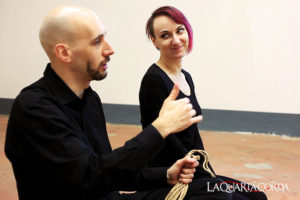
In this guide we’ll see some rules to know and follow to play safely with ropes. This guide is addressed both to tops and bottoms because knowledge, awareness and communication are essential to both.
We won’t talk about the risks of specific ties. You have to deal with these topics during a live class and not on an online guide.
It’s not possible to avoid completely all the risks. For this reason you have to be conscious and proactive, able to think in advance of the consequences of your behavior and ready to resolve at your best some dangerous situations.
In Japanese the word “joshiki” means the “common sense” and the knowledge generally accepted. A word that must be remembered during your bondage play.
NB: As much as this guide can be applied to every kind of bondage, its focus is on rope bondage.
ONE IMPORTANT PREMISE

If an incident occurs, you definitely didn’t do something properly.
Invoking the misfortune, the fate or saying – as many do – “it happens!” is just a way of avoiding to take your own responsibilities. You can call it bad luck only for events that go against all odds (e.g. a faulty carabiner or a calamity).
Safety handling is a task for both tops and bottoms. It’s a task for both inform and inquire about some problems or physical and psychological bottom’s characteristics.
It’s a top task adapting the ties to bottom’s characteristics and experience of the bottom and informing them about the risks and the attentions to be careful of during the play if they don’t have enough experience.
Shifting responsibility on the bottom when they don’t have any fault is wrong and cowardly. At the same time threatening and asking the bottom for not talking about an incident is a serious and craven act.
Both tops and bottoms must be aware that a risk margin of an incident is impossible to eliminate while playing. Personal conscience and mutual trust are essential to prevent it.
TEN GOLDEN RULES

CONSENSUALITY
Bondage must be a consensual activity, practiced of own free will and without any coercion.
It might be an obvious premise, but it’s very important that this consensuality should be given not only to avoid any form of physical violence but also without any psychological conditioning.
For example a photographer during a shooting could have some dangerous requests for the model’s safety, a dominant could force the submissive partner to do dangerous activities leveraging on their D/s relationship or someone could agree to tie or be tied in order to satisfy partner’s request although they doesn’t want to.
These situations should be avoided because, besides possible physical damages, they turn bondage into a negative experience, precluding sometimes the possibility of doing it serenely in the future.
TRUST
The second prerequisite if you desire a pleasant and safe bondage is the trust in your partner to avoid bad or even dangerous situations.
The bottom must be sure that the top ties safely. We’re not just talking about the experience: a beginner top can use ropes safely if they are aware of skills and limits and an experienced top could always have done it in a dangerous way.
The top has to trust the bottom too. The bottom has to be honest about them experience and physical and psychological characteristics and they have to be able to do correct feedbacks during the play. Not reporting about some problems not to quit the play, to make the impression of a strong person or to not diminish top’s abilities is very dangerous and can ruin the play experience.
Narcissism, the desire to show how you’re good and the thrill to experiment with new daring ties are enemies of a safe ropes session.
COMMUNICATION
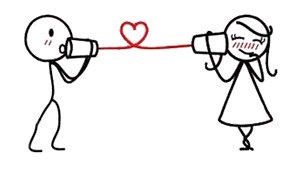
A good communication is at the root of a good bondage.
Incidents or bad episodes often happen just only for a lack of communication. Sometimes a good communication is enough to solve some little problems, like a rope that passes over a point that you don’t like or a bad tensioned one, a physical or psychological problem, embarrassment, etc.
The bottom mustn’t omit for fear of making them look bad; at the same time the top mustn’t think that asking how is the bottom denotes insecurity.
Communicating means above all having at heart yourself and your partner and it’s a sign of good competence.
SAFE WORD

During your bondage you can use a “safe word”, a prearranged word or gesture used to indicate the willingness to immediately stop the session for any reason and at any time.
You can choose any word simple to remember and not misunderstandable; for example “I can’t take it anymore!” or “stop!” are too generic expressions that can say even if you want to carry on.
When the bottom wears a gag, the safe word must be a non-verbal one, like a particular gesture.
Having a safeword is not required: many couples prefer to have a straight communication.
Pronouncing the safe word or asking to quit the game for a problem or because you have reached the limit is not a sign of lacking stamina for the bottom or inability for the top. It’s a sign of mutual trust and good awareness. The game won’t turn into a negative experience and you can carry on later!
Click on the image to discover the most used safewords on The Scope Archive!
SAFETY DISTANCE
Safety distance lets the top intervene in good time in case of problems. This distance may vary depending on the tie and on other factors.
For example, for a standing tied person with arms behind the back, the safety distance will be zero because they could fall by themself or due to a shove if in a crowded place.
Generally, don’t leave alone your tied bottom.
PSYCOPHYSICAL CONDITIONS
Alcohol, drugs, controlled substances, psychiatric drugs, etc.
Bondage is an activity that demands extreme attention and the capability to determine the consequences of an action. Every substance that compromises your ability to reason, danger perception or that produce a distorted sense of reality doesn’t allow you to do a safe bondage.
Tiredness, stress, hurry, privacy lack
In doing bondage you have to be relaxed, free of worries and have the time and the privacy you need. These are the conditions to tie and be tied in a peaceful and safe atmosphere.
When you want to do bondage, you have to choose an appropriate place and to carefully prepare everything you need; this way you’ll live a beautiful experience and not a clumsy obstacle race full of unexpected hurdles.
If you tie when you’re tired or worried about something, you risk transferring your feelings to the ropes and you can cause damages. Every stress compromises a good bondage.
Cold
The bottom, since they moves very little and can be scantily dressed, feels a room temperature lower than the real one, so you need an appropriate heating. A warm environment lets your muscles be stronger and more flexible and you can relax more easily.
Piercing, physical and health problems in general
Top and bottom should discuss about bottom’s physical or health problem in order to adapt the ties if it’s necessary.
Pay attention to piercings that could be caught up in ropes and torn away.
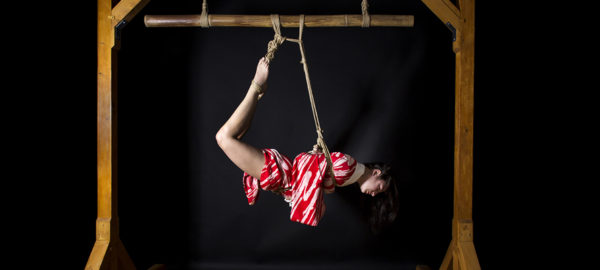
RISKS FOR RESPIRATORY SYSTEM
Many people think that the most dangerous risk of doing bondage is suffocation. It is actually easily avoidable; simply don’t put ropes in front of the neck. Tying the neck is not impossible but you have to be very expert to do it.
Respiration problems may occur in other situations. When your chest is tied or you are tied in positions with the torso bent forward or with the neck pulled backward, you may experience a feeling of oppression, true or presumed. In these cases you should fix or remove the tie, have a break, talk and try again later.
RISKS FOR CIRCULATORY SYSTEM
Another risk that can come to mind is a damage to the circulatory system. Actually, the eventuality to have damages caused by a reduced blood flow happens generally if the circulation interruption lasts for a significant time, unless you interrupt blood flow to the brain or if you have some specific physical problem. Moreover a reduced blood flow causes symptoms easily recognizable so the bottom can give feedback in case of problems.
In some ties it’s normal that a limb can be tied tightly and the blood flow can slow down; this situation can cause tingling, cooling, pallor or redness, cyanosis. With appropriate feedback you can handle all the problems avoiding annoying or dangerous situations. Moreover, attending a class, you’ll learn the correct tension and tightness of different ties.
There are some empirical methods to determine if the blood flow is reduced in a limb (e.g. checking the skin or nails color or trying to move your hands), but they aren’t reliable. The best solution is to learn to tie correctly and to have good communication with your partner.
In any case always avoid slipping ties (they become tighter when pulled) and ropes too close to the sides of the neck because, pushing on the carotid artery, can cause a blood drop to the head.
RISKS FOR THE NERVOUS SYSTEM
Nerve compression is probably the most dangerous risk when you play with ropes because it’s impossible to eliminate completely and it may occur suddenly.
All of us experimented the effects of a nerve compression; for example, when you sit with crossed legs your foot can numb. In this case you don’t have any perceivable symptoms before you try to move the leg; then you realize that the foot has become numb and you can’t move it. The problem is that, if you’re tied, you couldn’t move, so it could be difficult to be aware of possible nerve compression.
Nerve compression usually causes tingling, but it can be also asymptomatic. Its consequences are the impossibility of moving a part of your body for days, weeks or even some months.
Even though a nerve compression can happen more frequently in suspensions, it can occur also on floor work more often than you’d think.
Also a compression of a blood vessel is responsible for numbness, but a nerve issue causes tingling only in a part of a limb (for example only two fingers of the hand), whereas a blood one is extended to the whole limb (the whole hand). Moreover the tingling caused by reduced blood flow is progressive whereas symptoms of nerve compression could be unexpected.
In case of this kind of problem, the bottom has to report immediately them to the top to fix or untie the ropes.
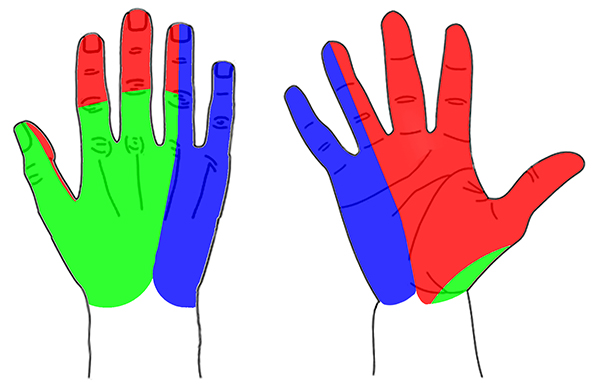
Tingling and sensibility loss in a specific area of the hand indicate a nerve compression.
Green zone: radia nerve
Blu zone: ulnar nerve
Red zone: median nerve
What to do in case of nerve compression?

First of all keep calm. The top has to provide emotional and practical support to the bottom who could be scared or needy.
Then you have to consider if medical attention is necessary. A tingling without functionality impairment and shortly resolving doesn’t need any particular therapy.
On the contrary a serious mobility loss that doesn’t improve within ten/twenty minutes or the presence of strong pain, limb deformation or hematoma needs medical attention.
If you call the emergency service or your doctor, clearly tell the origin of your incident (doing bondage), in order to avoid useless exams, time loss or suspicion of violence.
The doctor will probably give you a therapy (e.g. cortisone injection or a supplement prescription), then he will take into consideration the possibility of doing electromyography or an electroneurography in order to verify muscles and nerves functionality and the presence of other pathologies.
If you don’t seek medical advice, you can just wait for the complete recovery of limb functionality.
Don’t do stretching, don’t massage vigorously or compress the affected area.
Applying ice is probably useless for recovery.
If you have pain you can take a painkiller or an anti-inflammatory even if they don’t directly help the recovery.
A deficiency of group B vitamins can worsen nerve damage, so taking a supplement can be useful.
You can use a removable brace to protect the articulation from sudden movements or overnight.
You can move the limb the days after the incident without forcing.
The presence of the top during the recovery is very important to provide support to the bottom needs.
Attention: damages from nerve compression are cumulative! Be sure to have recovered the complete functionality before compressing again the same area with ropes.
WHERE DO THE MOST DANGEROUS NERVES PASS?
Both top and bottom must know the path of the nerves that more frequently are involved in ropes incidents.
Radial nerve
It origins in the axilla from brachial plexus, then turns behind the humerus and continues on the external part of the arm, passes superficially on the internal part of the elbow parallel to the median nerve, then go laterally to the radius on the forearm and passes the wrist on the side of the thumb.
This nerve is always very exposed: it’s vulnerable on axilla, forearm, elbow and wrist. Radial nerve compression causes in particular a capacity loss of grabbing objects with the hand and the wrist drop, the inability of holding the wrist in line with the forearm.
Ulnar nerve
It origins on the axilla from brachial plexus, passes internally on the arm parallel to the median nerve, then passes externally before the elbow and descends to the wrist on the side of the pinkie (it is opposite to radial nerve).
Even if the classical neuropathy of ulnar nerve verifies on the elbow (the shock you feel when you hit the elbow on a table), for bondage play the most sensitive points are the harm and the wrist.
Median nerve
It origins on the axilla from brachial plexus, passes internally on the harm parallel to ulnar neve, passes on the elbow protected by lacertus fibrosus, descends centrally on the wrist and enters in the carpal tunnel at the beginning of the palm.
Generally it isn’t subjected to injuries during bondage.
Sciatic nerve
It starts from sacral plexus at the end of the spine, passes behind the thigh and at the beginning of the popliteal cavity it’s divided into two branches: tibial nerve and the common peroneal nerve. The peroneal nerve innervates the anterior portion of the leg, the tibial nerve continues on the rear side and arrives to the foot. One of the common symptoms of prolonged pressure on the tibial nerve is the foot numbness when you stay for too long with crossed legs.
During bondage it could be compressed for example by a hip harness.
Femoral nerve
It origins from the spine, passes over hip bones and under the inguinal ligament, then splits into four branches that innervate the whole leg.
It can be compressed by a hip harness or by ties like ebi shibari where the chest is bent forward on the legs. Some people are particularly vulnerable to this position because the femoral nerve passes uncommonly over the inguinal ligament.
That tingling in the fingers…
One of the most frequent problems in doing bondage is the feeling of tingling in hands for those ties that involve arms.
As already seen, this problem can be caused by blood circulation slowing down or by nerve compression.
If the problem comes from a slower blood circulation the numbness is extended to the whole hand. You don’t need to untie immediately because, unless specific physical problems, a circulation slowing down doesn’t implicate an immediately dangerous situation. Some bottoms aren’t so annoyed about it, some don’t bear it at all, with someone this tingling occurs immediately, with others less frequently. However it’s a sign of an ongoing issue that has to be resolved anyway.
If the problem is caused by nerve compression, the tingling is restricted only to a specific area of the hand, for example only two fingers.
Unfortunately sometimes a nerve compression can arise when the hand is already numb because of a blood issue or even it can be apparently asymptomatic. In this situation recognising the problem could be very difficult.
Nerve damage can arise suddenly and cause serious damage within a few seconds, especially if you are suspended.
Regarding radial (and median) nerve the most important check is trying to lift the thumb closing the other fingers (the “thumbs-up” position). If you aren’t able to do this check, the radial nerve has been compromised.
Moreover you can try to touch and push the other fingertips with the thumb (doing an “ok” one finger at a time) to check if the functionality is the same for all the fingers. If some are less sensitive or weaker than the others this can be caused by nerve compression.
You can also check the functionality of the hand opening it completely; the difficulty in extending completely the pinkie is a sign of ulnar nerve compression.
Remember that it’s better raising the alarm than ignoring a sign of complaint or danger and ending the tie with more or less serious damage.
Keep in mind that safety for this kind of ties is not only about “where” but also “how” the rope passes. For this reason it’s very important to have classes with experienced teachers that can give you fundamental recommendations about doing this kind of tie at the best.
Bottoms must be prepared too. A bottom that can give the right feedbacks and that knows them nerves paths and consequently the best ropes placement on them own body could inform the top about them needs, contributing to a pleasant and safe ropes session. This behaviour doesn’t make the bottom look apprehensive or belittling about the top; on the contrary it’s a sign of attention and preparation.
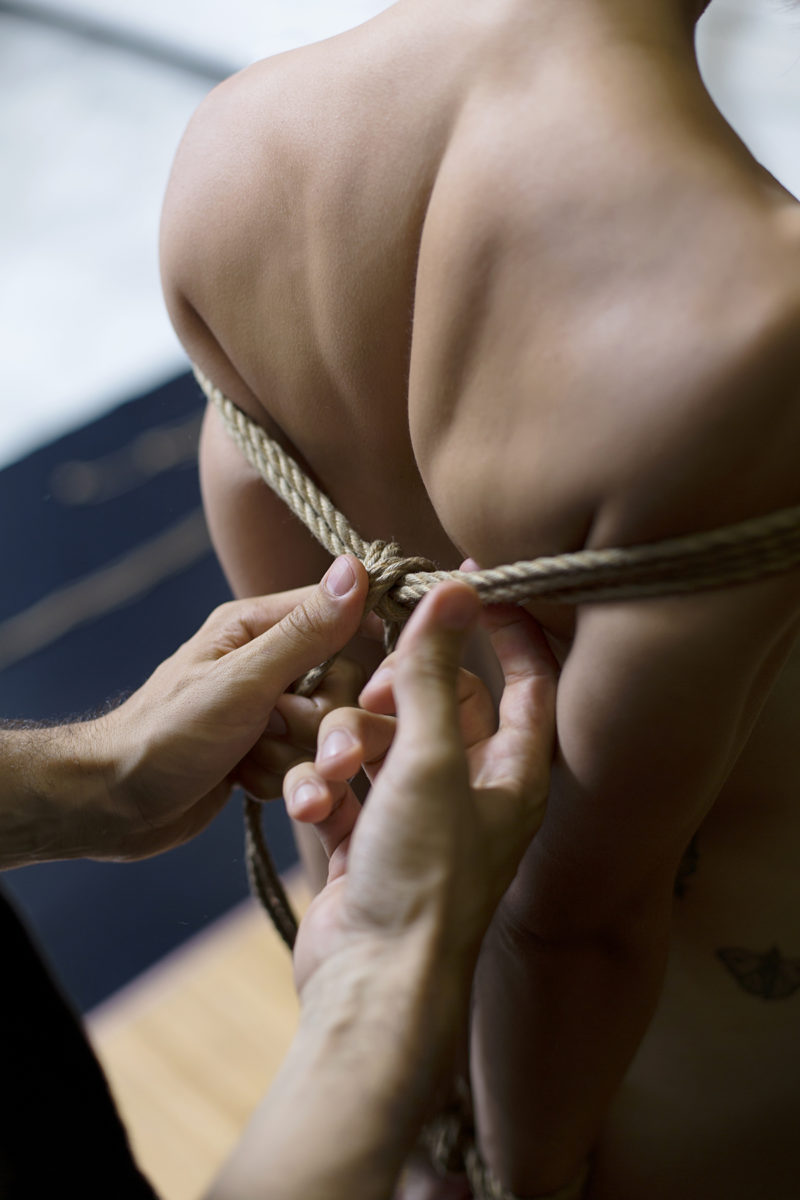
WHERE TO BE CAREFUL
Axillae
Any rope that passes under axillae cannot be used to suspend and there mustn’t be any knot that plunges into the axilla; here are sited the brachial plexus (from which radial, ulnar and medial nerves start) and some big arteries (axillary and brachial artery).
Arms
Any tensioned rope on the arm can push on points where nerves aren’t protected, especially radial and ulnar nerve.
This can happen especially with harnesses that involve arms, for example gote, causing a very dangerous compression.
Attending a workshop about this kind of ties is recommended to know the correct realization and to limit the risk of the damage.
Elbows
The internal part of elbows can’t be compressed, for example with a knot that pushes on this area. Some brachial nerves could be damaged.
Wrists
In wrists ties, ropes and knots mustn’t push sideways at the height of carpus (the dimples on the sides of the wrist where you detect the pulse); in this case radial and ulnar nerve could be compressed (the so-called “handcuffs neuropathy”).
Be careful that ropes or knots won’t beat on the back of the hand, a sensitive area where some tendons could be damaged.
Groin
As for axillae, the groin is a dangerous area for ropes; you can tie the groin but without putting tension in a vertical direction to avoid compression of nerves or blood vessels.
Knees
As said for elbows, knots pressing on the internal area of the knee are dangerous because on the popliteal region are present the popliteal artery and the tibial nerve whose compression can cause foot sensibility loss.
Ankles
Unlike wrists, ankles are quite protected. Be careful to not put ropes and knots on the back of the foot, as said for hands.
Spine
Putting ropes or knots on the spine is not dangerous unless they push on it, for example if the bottom is lying down.
Face
Ropes can be put on the face but be careful because a very tighten rope, above all on eyes and ears, can be annoying or even dangerous.
FALLS
When you’re immobilized, unless you’re secured to a structure, the risk of falling increases, if only standing or if you receive a push; moreover, a bottom with tied hands or arms can’t protect themself in case of falling, risking of hitting head or shoulders.
The bottom has to be careful to not move unnecessarily if they are in precarious balance. But above all the top mustn’t leave alone the partner and must hold them up when they are standing or moving.
FAINTINGS
It can happen to faint due to a pressure drop, hypoglycemia, for being stationary too long, for medicines influence, for simple emotional factors, etc.
Fainting can be dangerous during bondage for the same reasons listed for falling; moreover the situation can be more problematic if the bottom is suspended because they become a dead weight difficult to handle.
In case of consciousness loss during a suspension, if you are alone, don’t cut the ropes that support the body but get down one body part at a time or release gradually the whole body to avoid the bottom being a dead weight on you, making the rescue unsafe.
In case of falling put the person lying with slightly lifted legs, supporting the head to avoid the tongue going backward choking them. In general the best thing to do is to quickly untie or even cut the ropes, especially if they don’t let a regular blood flow or good breathing.
If the person doesn’t regain consciousness quickly, if there isn’t heartbeat or respiration or other symptoms arise, call immediately the emergency service and follow their instructions.
OTHER LITTLE ATTENTIONS
Rope on eyes
Be careful not to throw ropes on the eyes accidentally, always controlling the movement of ropes.
Panic attack
It can happen that the person you tie has a panic attack due to the constraint feeling caused by ties or just for psychological factors. In this case remain calm and quickly untie or even cut the rope, taking care of the bottom and trying to calm them down.
Cramps
Sometimes cramps may arise; if the limb affected is tied you have to untie or cut the ropes to let the bottom move it to release the muscle.
Pay attention that also tops can have cramps! If you have been tying for many hours, a cramp in your hand may arise; if it happens, it’s necessary to think about the safety of the bottom, asking someone for help if present.
Others
Bottoms better not to wear bracelets, wristwatches, anklets, necklaces, rings or other jewels that could be an obstacle or even dangerous in doing bondage.
THE IMPORTANCE OF TECHNIQUE
It’s worth recalling that technique is one of the most important factors to reduce the risk of having a rope incident: a well done and well-handled tie won’t cause a problematic situation.
Generally speaking, the passages of a well-done tie must have the following features:
Attending classes or workshops is fundamental to learn a good technique.
Ropemarks aren’t usually dangerous but you have to take into account that they can be barely justifiable for some people in public situations like gyms, swimming pools, at sea, etc. or for models that need to have a body without blemishes.
It’s better to clarify with the bottom the possibility to have ropemarks after the session, but they are still not permanent.
Pression marks
When ropes press on the skin, they leave a mark, a groove more or less deep depending on the area of the body and on the pressure exercised; these marks will disappear in a short time and aren’t dangerous.
Ecchymosis
Sometimes it can happen that the pressure of the ropes can result in bruises, but the skin can also be pinched between two ropes, especially if the ropes are not well placed, if the skin is particularly sensitive, during suspensions and especially in sensitive areas, like the waist. In this case red stripings appear; they aren’t dangerous and will disappear in a few days.
Petechial hemorrhaging
Petechial hemorrhaging is a subcutaneous bleeding that produces punctiform red spots (petechiae) on skin. Petechiae can appear during bondage when the pressure of ropes causes the break of surface capillaries. Some people are more sensitive to this pathology. In case of an upside-down suspension it can happen also around eyes. Petechiae aren’t painful and reabsorb in a few days.
Burns
When a rope runs on the skin too fast, the rubbing generates heat that can cause a burn. Burns may occur caused also by the pressure of ropes on skin. It’s possible that little blisters (vesicles) form. They reabsorb in a few days.
FOR THOSE WHO TIE
One of the tasks of those who tie is to have a good technical background.
If you tie someone that is not aware of safety aspects, you have to inform them in order to actively contribute to the realization of a safe bondage.
Inquire about possible physical and psychological problems of your partner and negotiate the limits within which the play can be held.
Don’t overcome the limits agreed upon with your partner. In ropes, as in life, “no” means “no”.
FOR THOSE WHO GET TIED UP
Safety is an important aspect that concerns both tops and bottoms. A well-informed bottom, able of a good communication, actively contributes to safety.
We already talked about the importance of not lying during the ties: if a problem occurs, don’t say nothing to not appear weak, for fear of diminishing top’s abilities or to not stop the session could be very dangerous.
Sometimes a little change is enough to continue playing without worries: a finger between ropes, a rope few millimeters moved, a position adjustment can make the difference between a dangerous or even just annoying experience and a enjoyable and satisfying one.
A false alarm is always better than an incident.
Say clearly at the beginning of the session if you have some physical or psycological problems and negotiate the limits within which the play can be held.
Moreover, especially if you do bondage regularly, training and stretching can be beneficial: a fit body is less vulnerable during ties.
Don’t do intense stretching before the session. It’s bettert to warm up muscles moving and stretching them a little bit. Stretching is a very useful activity but requires time to be done properly. Do it steadily if you want long-lasting results.
In the end, as the top needs to have respect for the bottom, also those who get tied up need to have a positive behaviour. Be patient with those who are novices, don’t be aggressive in case of some little mistakes or accidental oversights and in case don’t forget to espress your satisfaction to the top that tied you.
Ropespace
Ropespace is a state of altered consciousness, of alienation, that a bottom can experience when the feelings between ropes are very intense. It’s like a rapture state that makes the bottom forget about the world around, abandoning completely themself to rope play. This causes a release of muscular tensions, a deeper breathing, a reduced pain perception.
For those who are tied up, being in ropespace is a very deep and intense experience, so much that at the end, when you come back to reality, you can feel a sense of disorientation, loneliness, sadness and it may happen to cry. Knowing this possibility is very important to avoid confusing it with a mistake in play management or with a bad feeling.
The person who has experienced an intense ropespace, feeling a general sense of discouragement, hasn’t to be ashamed and the person who tied has to be close to the partner in order to comfort them after removing ropes.
Be careful that, if a bottom is in ropespace, they couldn’t be able to communicate possible problems: in this case, it is very important to be extremely careful.
ROPES
Generally natural or synthetic fibers ropes (cotton, jute, hemp) are used to do bondage.
Some people are allergic, even only slightly, to some materials; if the skin of the bottom turns red, maybe the person is allergic.
A particular aspect to consider is about the breaking load in suspension, or rather the weight that a rope can hold up without breaking. Some material has a very low breaking weight (e.g. cotton), others are particularly resistant (e.g. linen, hemp, most of the synthetic fibers). However it’s impossible to establish a priori a rope breaking load, because this value is influenced by the kind of fiber used and how it has been used (preparation underwent, wear, etc.). Unfortunately, when a rope breaks, it suddenly “explodes” and this can cause a serious incident for the person suspended.
Especially tor suspensions, ropes must be appropriate for this use and in good conditions; for example, cotton ropes don’t offer enough resistance and jute or hemp ropes should be not less than six millimeters thick to be used for main suspension lines.
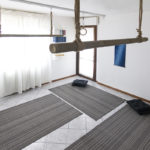
HARDWARE
Check (if it’s possible) the stability of the structures you want to use both for suspensions and floorwork; the structure can bear a weight greater than a person’s one since the load weighing on the anchor point is dynamic. A not sufficiently robust structure can cave in after a jerk. Don’t use structures if you don’t know their load capacity.
Tops must always have at hand a safety device to cut ropes.
The best solution is safety scissors (EMT scissors). Devices as knives, trimmers, shears, generic scissors can’t be used, because they can be not enough efficient or too sharp. In the second case they can cut the flesh or, having a not sufficiently rounded tip, they can wound, especially if the person is panicking.
In case of an incident you are not always supposed to cut the ropes; sometimes you can simply untie quickly a part of the body to secure the bottom, then you can untie calmly the rest of the tie. Sometimes cutting ropes can be even dangerous, for example if the bottom is suspended or fainted, because you can’t be able to support the body.
Try to consider carefully but promptly every dangerous situation.
Safety scissors
Safety scissors – or emergency scissors or EMT scissors (Emergency Medical Technician) – have round and flat tip to enter between ropes without scratching the skin and a serrated blade in order to not cut accidentally. They are cheap and very efficient. They have to be used only for emergency so that they are at their peak efficiency when used.
“Aftercare” refers to the attention to give and get after doing bondage.
We talk about it in a guide on safety since a rope session, as well as safe, has to be pleasant and satisfying too. In order to do this you have to take a final moment to “come back to reality” and feel satisfied and protected.
Keep in mind that, at the end of a bondage session, the bottom can get cold, hungry or thirsty. It’s useful to have a blanket, a drink and something to eat.
The moment when ropes have been taken off has to be full of attentions and emotions as during the ties. Don’t waste this moment!
“Most of the aftercare emotional component lies in an appreciation desire ” (Midori, “The seductive art of Japanese bondage”). Both tops and bottoms, after the physical and mental struggle of doing bondage, need to be reassured, to feel like it was a wonderful experience, to feel good both as models and riggers; often a hug or a whispered word are the best gratifications.
Everyone can find the best aftercare: once taken off the ropes, you can have sex or have an intimate moment, hug each other and be close, stay alone, talk or stay in silence.
Remember that appreciated tops and bottoms will play more gladly with you next time!
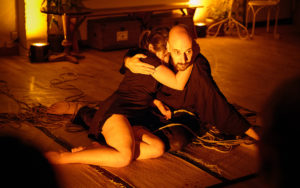
Translation
![]() Coldeyes is a Pole Dance teacher and a Kinbaku performer. She discovered Kinbaku in 2015 thanks to Andrea of La Quarta Corda, with whom she realized various photographic projects such as Keibatsu, inspired by traditional Japanese tortures. She performed and teached in Italy and at important international events. She experiences ropes in a very intimate and essential way, with no mannerism.
Coldeyes is a Pole Dance teacher and a Kinbaku performer. She discovered Kinbaku in 2015 thanks to Andrea of La Quarta Corda, with whom she realized various photographic projects such as Keibatsu, inspired by traditional Japanese tortures. She performed and teached in Italy and at important international events. She experiences ropes in a very intimate and essential way, with no mannerism.
Facebook